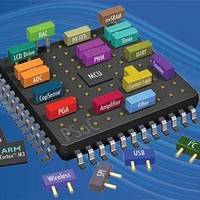CY8C3866AXI-040 Cypress Semiconductor Corp, CY8C3866AXI-040 Datasheet - Page 28

CY8C3866AXI-040
Manufacturer Part Number
CY8C3866AXI-040
Description
PSOC 3 TQFP
Manufacturer
Cypress Semiconductor Corp
Series
PSOC™ 3 CY8C38xxr
Datasheet
1.CY8C3865LTI-058.pdf
(129 pages)
Specifications of CY8C3866AXI-040
Package / Case
*
Voltage - Supply (vcc/vdd)
1.71 V ~ 5.5 V
Operating Temperature
-40°C ~ 85°C
Speed
67MHz
Number Of I /o
62
Eeprom Size
2K x 8
Core Processor
8051
Program Memory Type
FLASH
Ram Size
8K x 8
Program Memory Size
64KB (64K x 8)
Data Converters
A/D 2x20b, D/A 4x8b
Oscillator Type
Internal
Peripherals
CapSense, DMA, LCD, POR, PWM, WDT
Connectivity
CAN, EBI/EMI, I²C, LIN, SPI, UART/USART, USB
Core Size
8-Bit
Processor Series
CY8C38
Core
8051
Data Bus Width
32 bit
Data Ram Size
8 KB
Interface Type
I2C, SPI, UART, USB
Maximum Clock Frequency
67 MHz
Number Of Programmable I/os
28 to 72
Number Of Timers
4
Operating Supply Voltage
0.5 V to 5.5 V
Maximum Operating Temperature
+ 85 C
Mounting Style
SMD/SMT
Controller Family/series
(8051) PSOC 3
No. Of I/o's
62
Eeprom Memory Size
2KB
Ram Memory Size
8KB
Cpu Speed
67MHz
Lead Free Status / RoHS Status
Lead free / RoHS Compliant
Lead Free Status / RoHS Status
Lead free / RoHS Compliant
Available stocks
Company
Part Number
Manufacturer
Quantity
Price
Company:
Part Number:
CY8C3866AXI-040
Manufacturer:
Cypress Semiconductor
Quantity:
135
Company:
Part Number:
CY8C3866AXI-040
Manufacturer:
NXP
Quantity:
112
Company:
Part Number:
CY8C3866AXI-040
Manufacturer:
Cypress Semiconductor Corp
Quantity:
10 000
Part Number:
CY8C3866AXI-040
Manufacturer:
CYPRESS/赛普拉斯
Quantity:
20 000
Company:
Part Number:
CY8C3866AXI-040ES2
Manufacturer:
CYPRESS
Quantity:
153
The 33-kHz clock (CLK33K) comes from a divide-by-3 operation
on CLK100K. This output can be used as a reduced accuracy
version of the 32.768-kHz ECO clock with no need for a crystal.
6.1.2 External Oscillators
6.1.2.1 MHz External Crystal Oscillator
The MHzECO provides high frequency, high precision clocking
using an external crystal (see
variety of crystal types, in the range of 4 to 25 MHz. When used
in conjunction with the PLL, it can generate CPU and system
clocks up to the device's maximum frequency (see PLL). The
GPIO pins connecting to the external crystal and capacitors are
fixed. MHzECO accuracy depends on the crystal chosen.
Figure 6-2. MHzECO Block Diagram
6.1.2.2 32.768-kHz ECO
The 32.768-kHz external crystal oscillator (32kHzECO) provides
precision timing with minimal power consumption using an
external 32.768-kHz watch crystal (see
32kHzECO also connects directly to the sleep timer and provides
the source for the RTC. The RTC uses a 1-second interrupt to
implement the RTC functionality in firmware.
The oscillator works in two distinct power modes. This allows
users to trade off power consumption with noise immunity from
neighboring circuits. The GPIO pins connected to the external
crystal and capacitors are fixed.
Figure 6-3. 32kHzECO Block Diagram
Document Number: 001-11729 Rev. *R
Components
Components
External
(Pin P15[3])
External
(Pin P15[1])
Xi
Xi
Crystal Osc
Crystal Osc
4 - 25 MHz
32 kHz
(Pin P15[2])
32 kHz
(Pin P15[0])
crystal
Capacitors
4 –25 MHz
Capacitors
Xo
crystal
XCLK_MHZ
Xo
XCLK32K
Figure
6-2). It supports a wide
Figure
6-3). The
6.1.2.3 Digital System Interconnect
The DSI provides routing for clocks taken from external clock
oscillators connected to I/O. The oscillators can also be
generated within the device in the digital system and UDBs.
While the primary DSI clock input provides access to all clocking
resources, up to eight other DSI clocks (internally or externally
generated) may be routed directly to the eight digital clock
dividers. This is only possible if there are multiple precision clock
sources.
6.1.3 Clock Distribution
All seven clock sources are inputs to the central clock distribution
system. The distribution system is designed to create multiple
high precision clocks. These clocks are customized for the
design’s requirements and eliminate the common problems
found with limited resolution prescalers attached to peripherals.
The clock distribution system generates several types of clock
trees.
Each clock divider consists of an 8-input multiplexer, a 16-bit
clock divider (divide by 2 and higher) that generates ~50 percent
duty cycle clocks, system clock resynchronization logic, and
deglitch logic. The outputs from each digital clock tree can be
routed into the digital system interconnect and then brought back
into the clock system as an input, allowing clock chaining of up
to 32 bits.
6.1.4 USB Clock Domain
The USB clock domain is unique in that it operates largely
asynchronously from the main clock network. The USB logic
contains a synchronous bus interface to the chip, while running
on an asynchronous clock to process USB data. The USB logic
requires a 48 MHz frequency. This frequency can be generated
from different sources, including DSI clock at 48 MHz or doubled
value of 24 MHz from internal oscillator, DSI signal, or crystal
oscillator.
The system clock is used to select and supply the fastest clock
in the system for general system clock requirements and clock
synchronization of the PSoC device.
Bus clock 16-bit divider uses the system clock to generate the
system's bus clock used for data transfers. Bus clock is the
source clock for the CPU clock divider.
Eight fully programmable 16-bit clock dividers generate digital
system clocks for general use in the digital system, as
configured by the design’s requirements. Digital system clocks
can generate custom clocks derived from any of the seven
clock sources for any purpose. Examples include baud rate
generators, accurate PWM periods, and timer clocks, and
many others. If more than eight digital clock dividers are
required, the UDBs and fixed function timer/counter/PWMs can
also generate clocks.
Four 16-bit clock dividers generate clocks for the analog system
components that require clocking, such as ADC and mixers.
The analog clock dividers include skew control to ensure that
critical analog events do not occur simultaneously with digital
switching events. This is done to reduce analog system noise.
PSoC
®
3: CY8C38 Family
Data Sheet
Page 28 of 129
[+] Feedback












